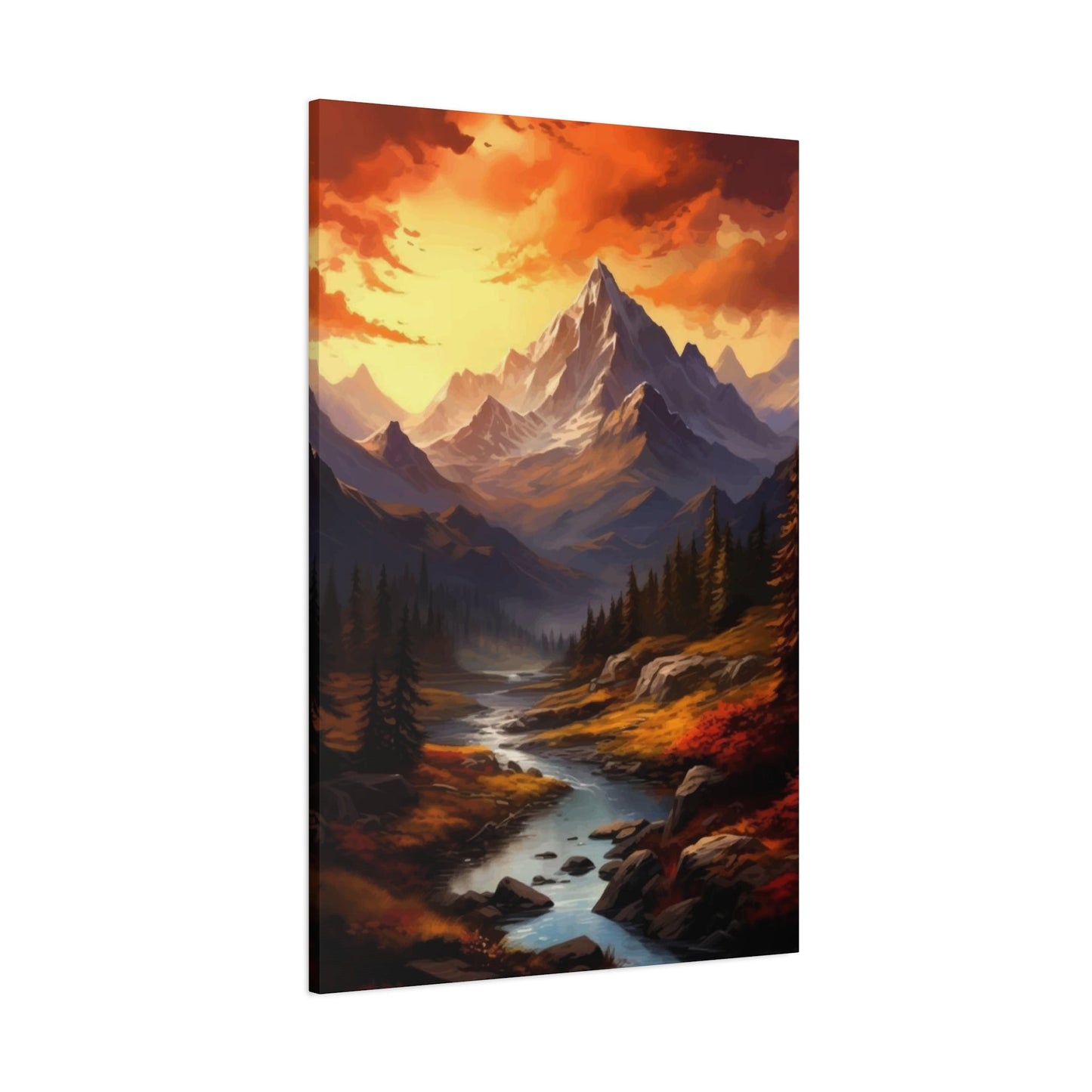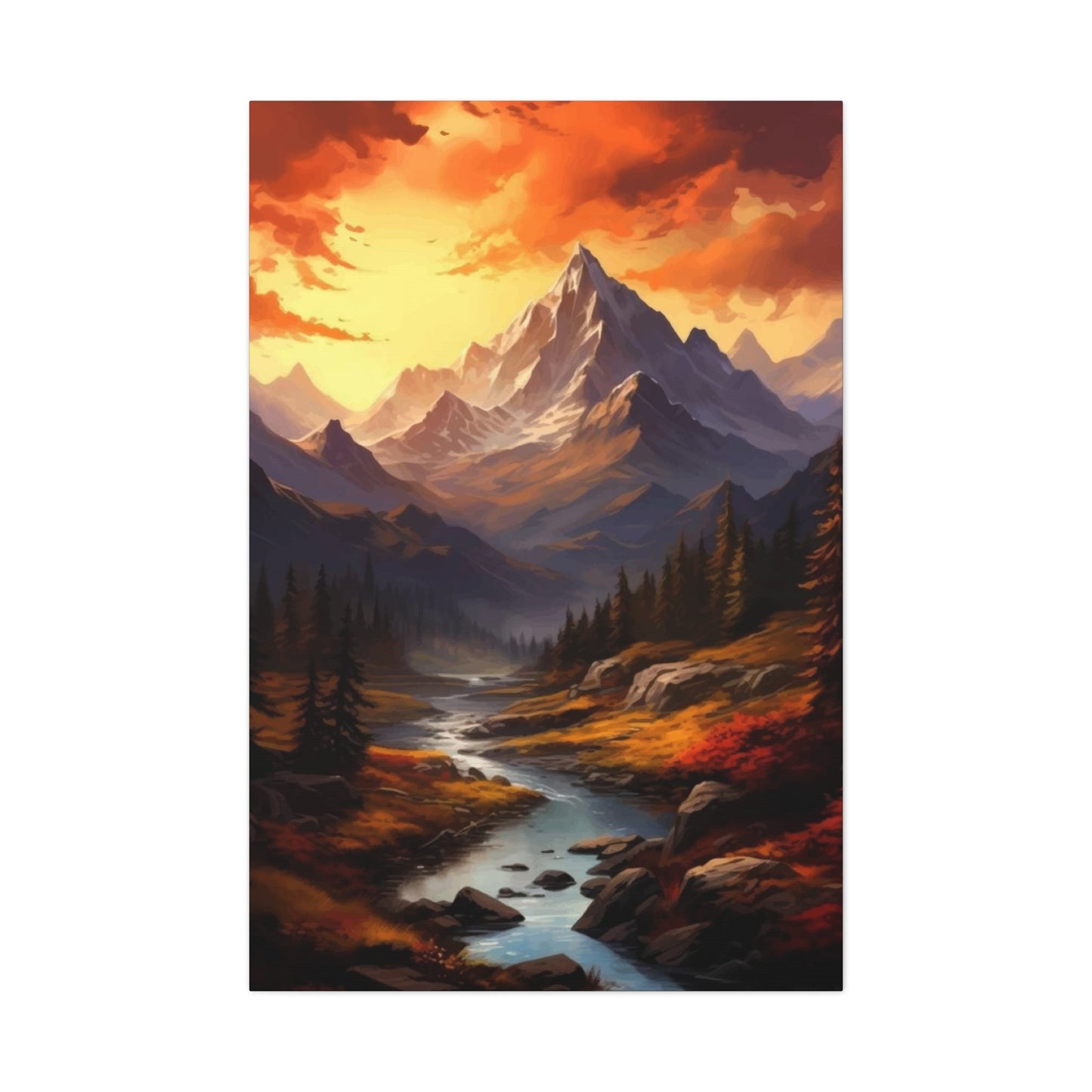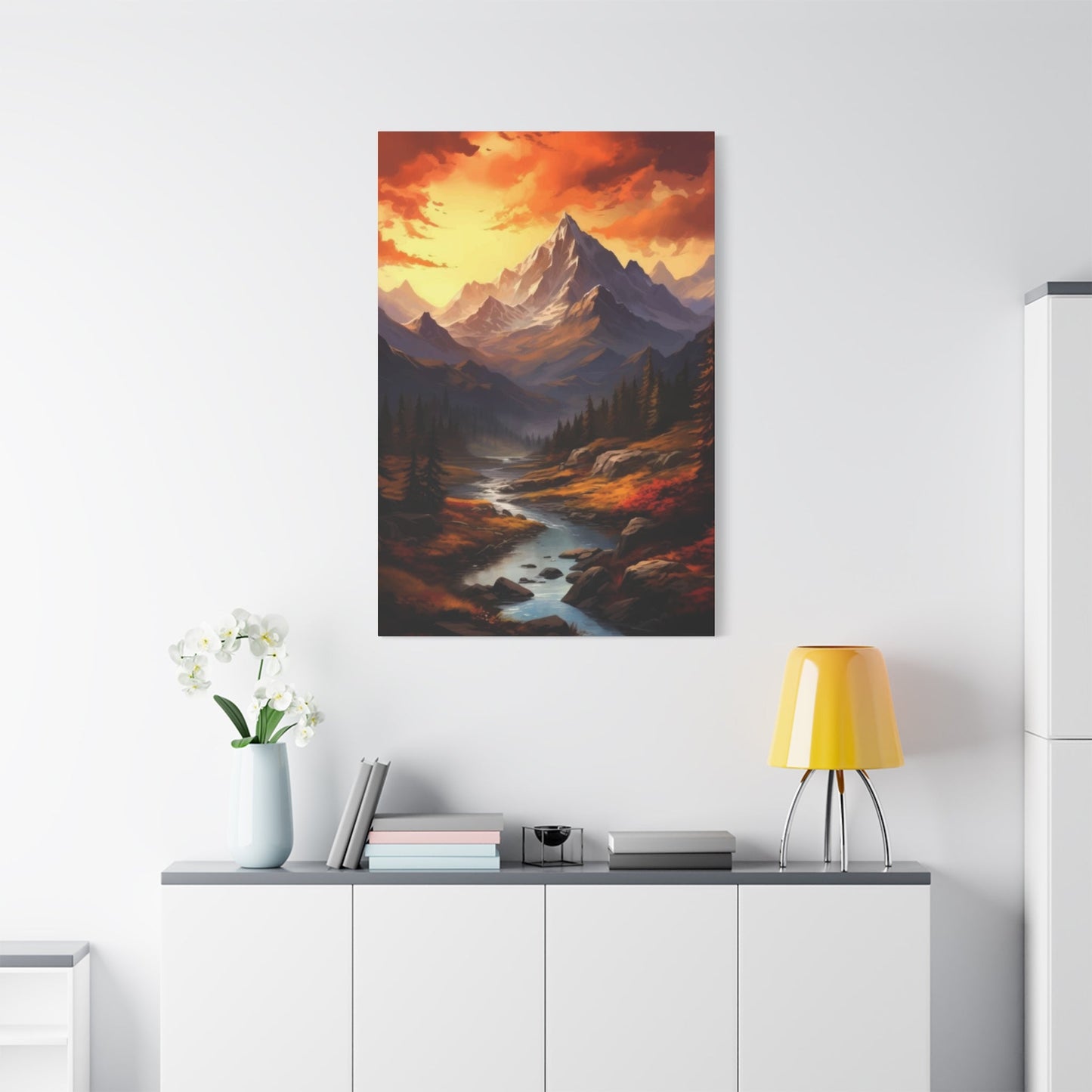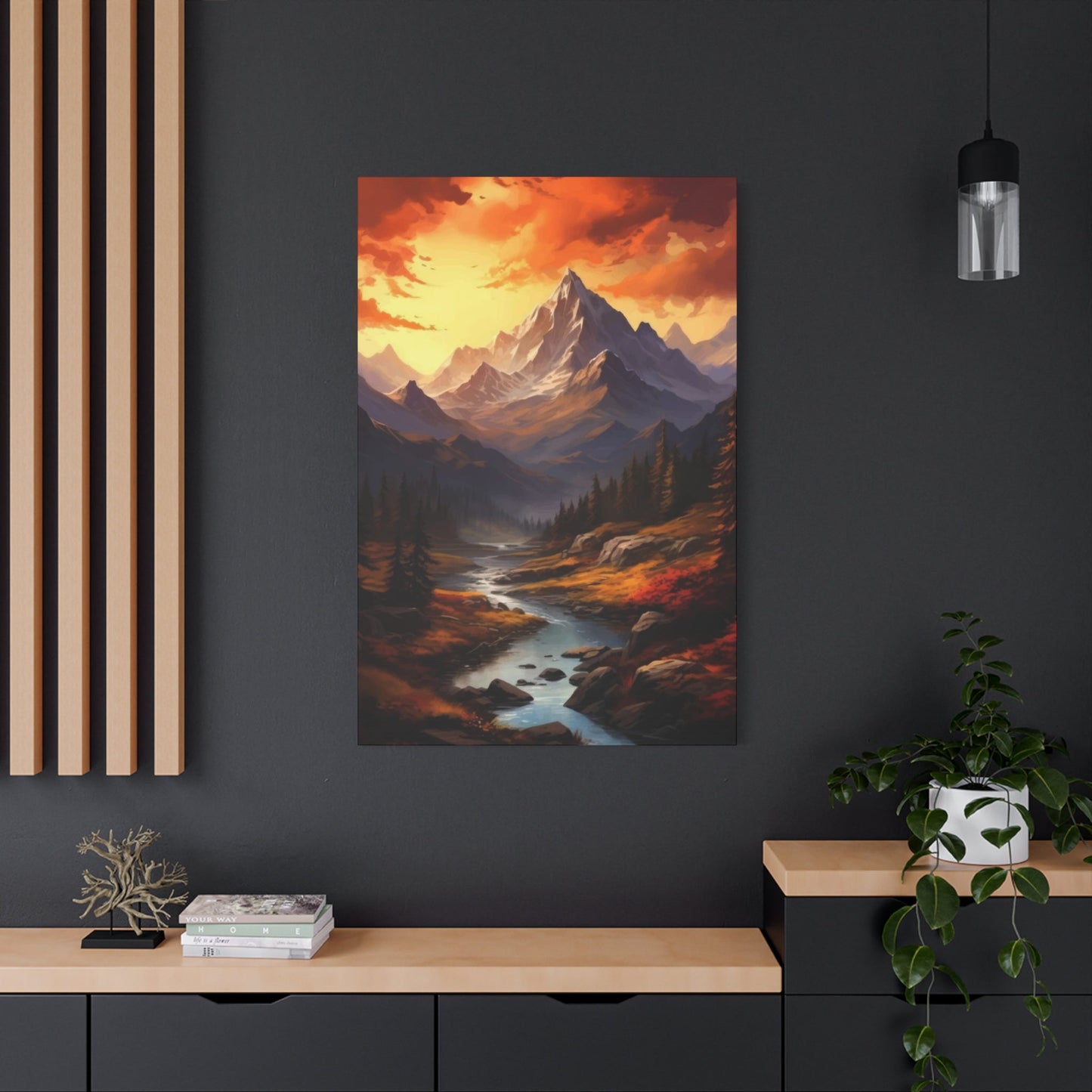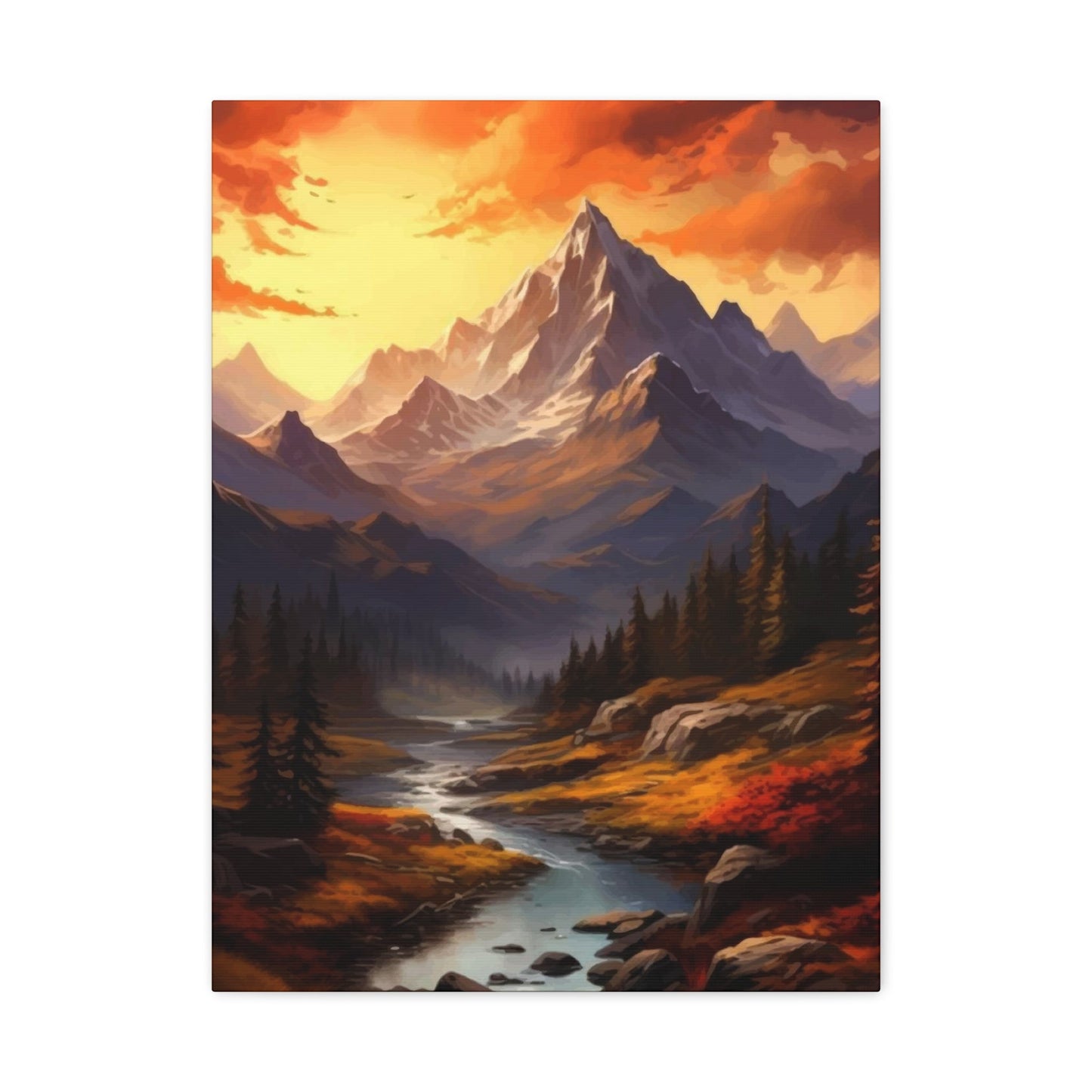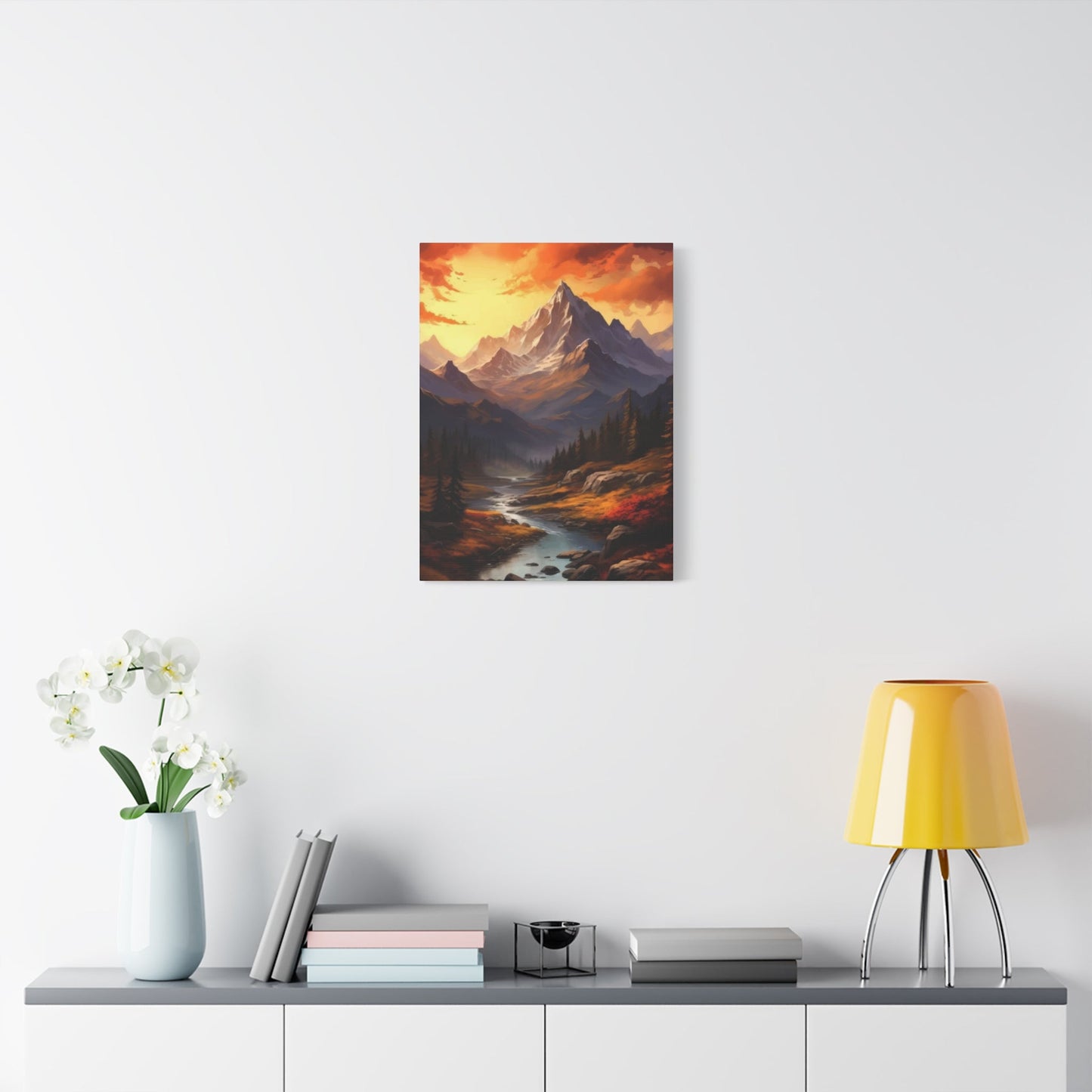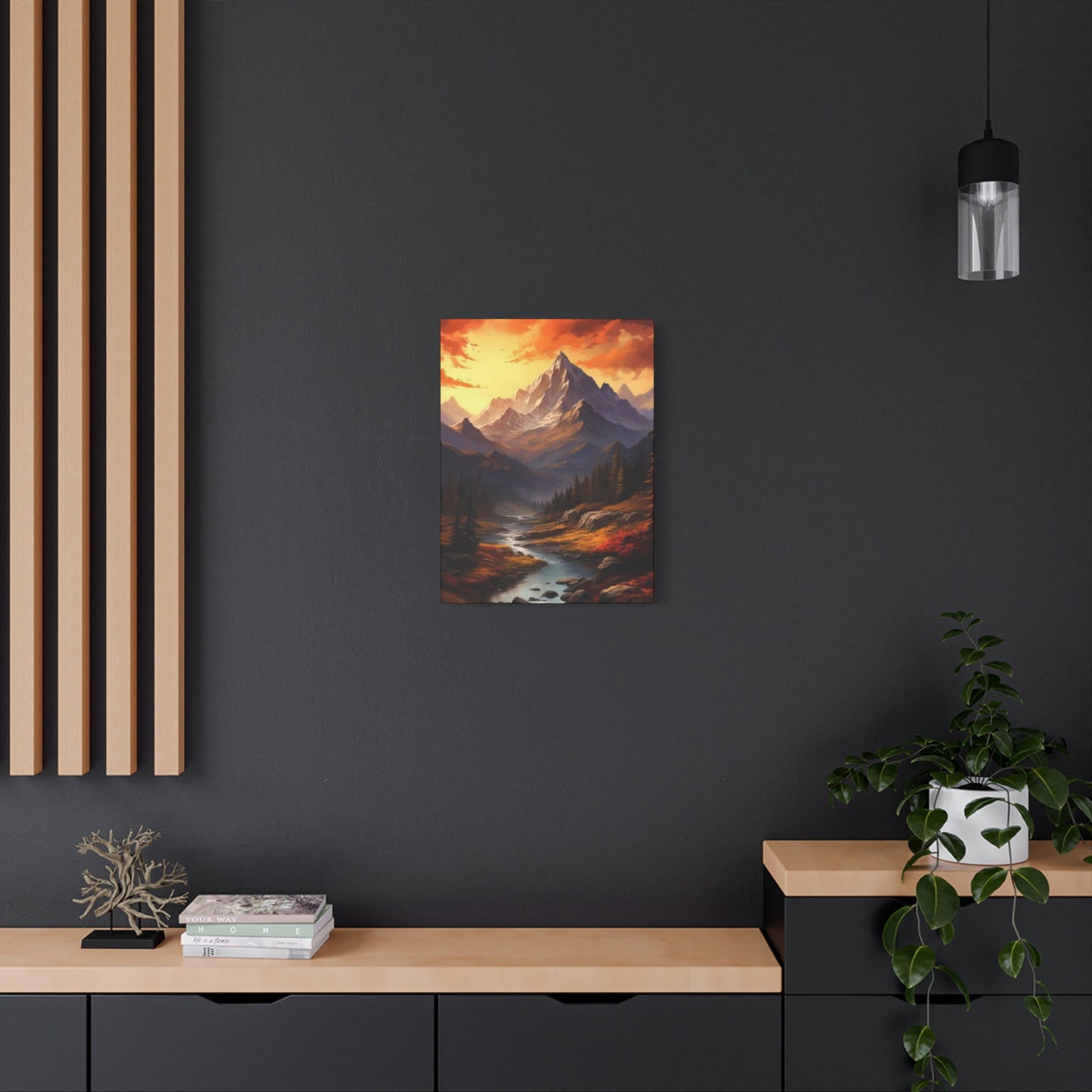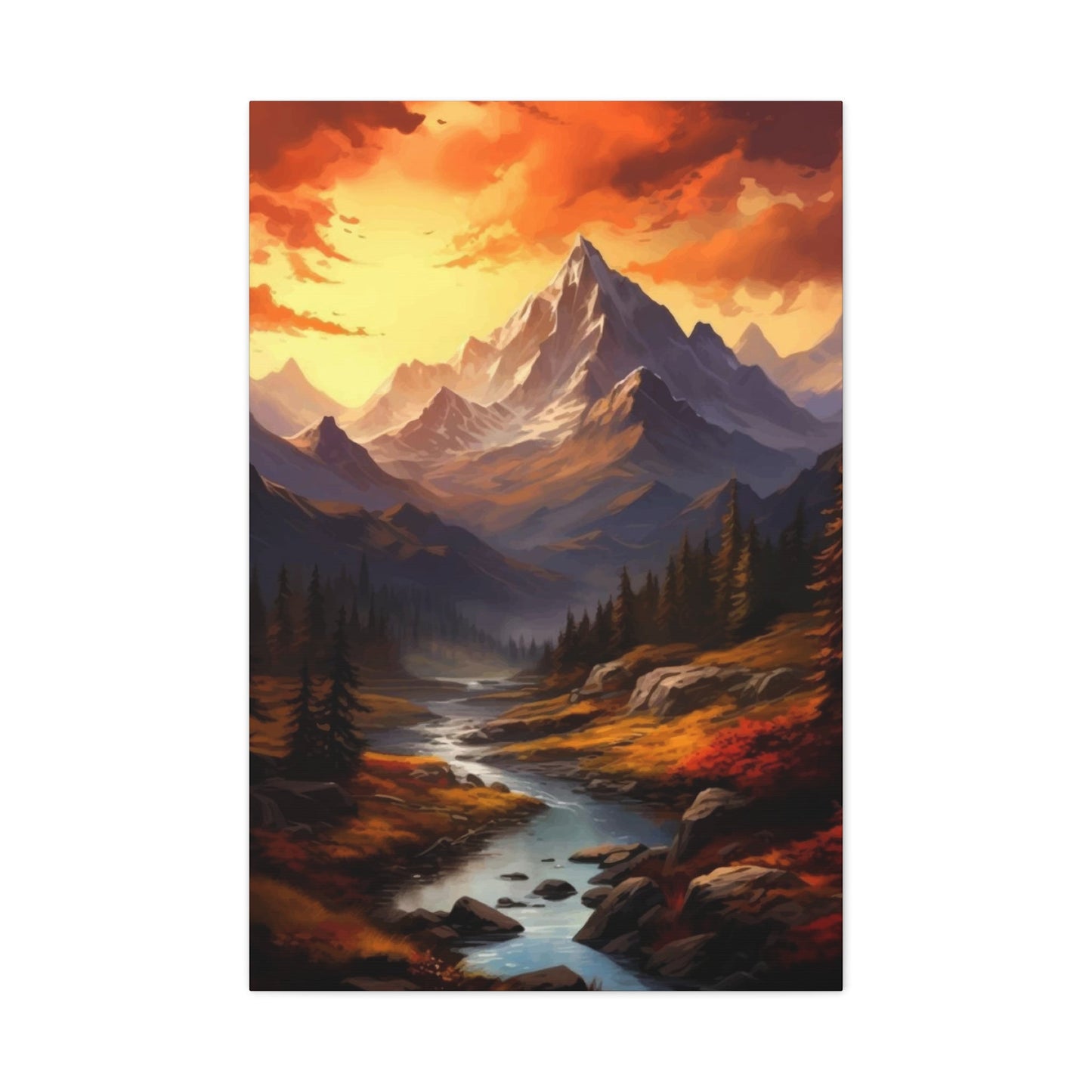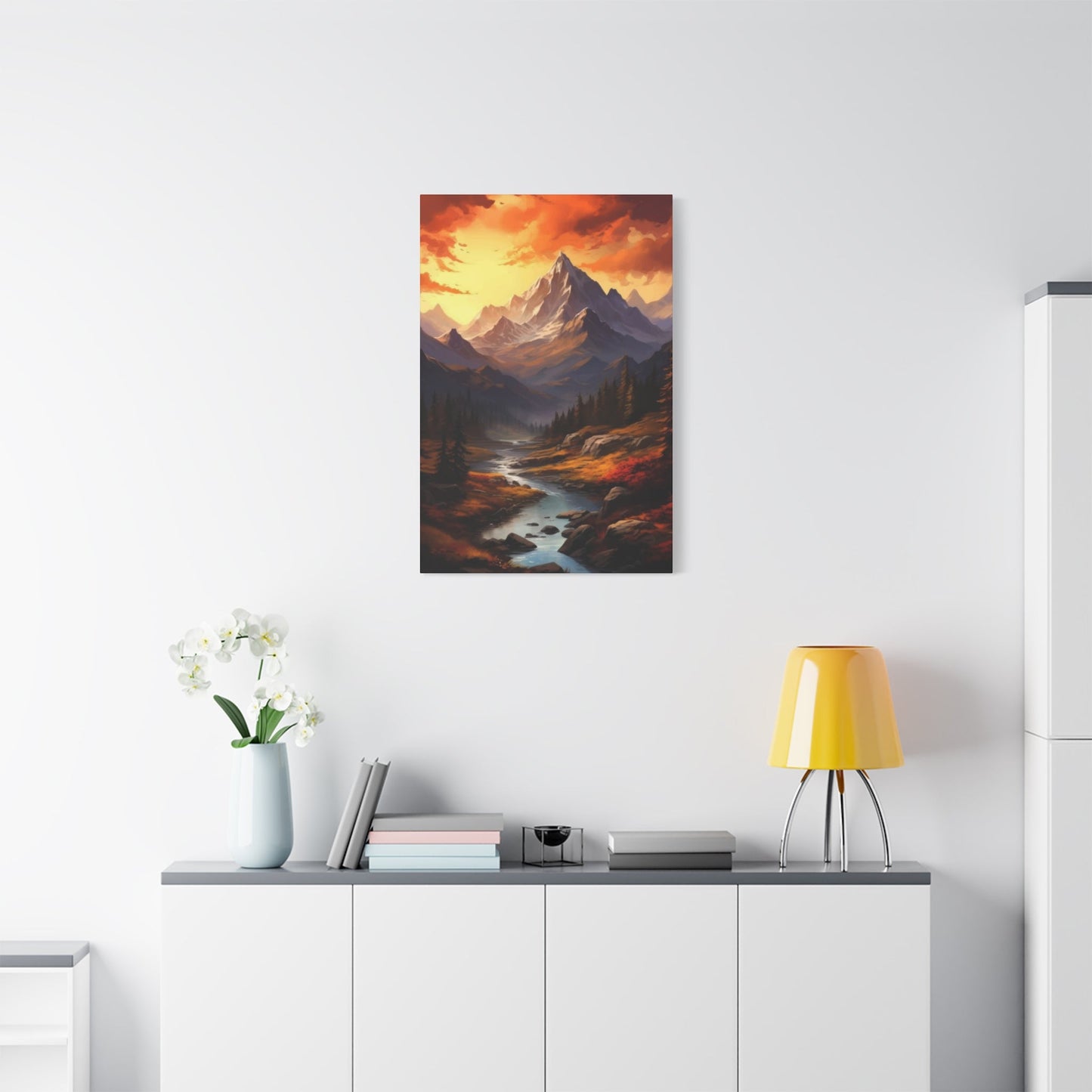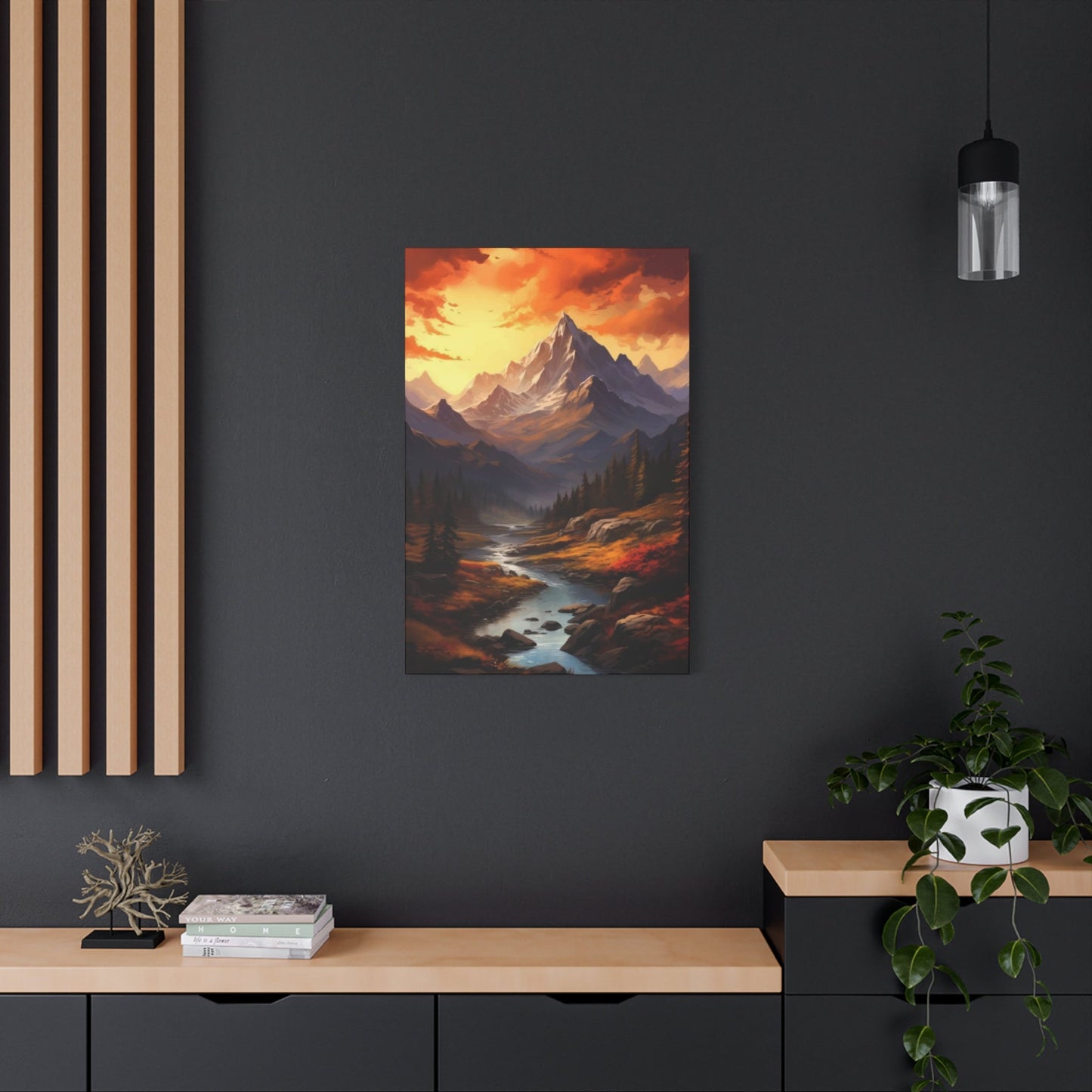Mountain Stream Wall Art: Transform Your Home with Nature's Flowing Beauty
Mountain streams have captivated humanity for centuries with their mesmerizing flow, crystal-clear waters, and the peaceful ambiance they create. When translated into visual artworks, these natural wonders become powerful decorative elements that can transform any living environment into a tranquil sanctuary. The incorporation of flowing water imagery through carefully selected artwork offers homeowners an opportunity to bring the calming essence of nature directly into their daily surroundings.
The appeal of mountain stream imagery extends far beyond mere aesthetic pleasure. These artworks serve as windows to the natural world, offering viewers a momentary escape from the hustle and bustle of modern life. Whether rendered in photographic detail or interpreted through abstract artistic expression, stream-themed artwork possesses an inherent ability to evoke feelings of peace, renewal, and connection with the natural environment.
In today's fast-paced world, creating environments that promote relaxation and mental well-being has become increasingly important. Mountain stream artwork provides an accessible and effective means of achieving this goal, allowing individuals to experience the therapeutic benefits of nature without leaving their homes. The gentle movement suggested by flowing water imagery can help reduce stress, lower blood pressure, and promote a sense of overall tranquility.
The Serenity of Mountain Streams in Art
The profound tranquility associated with mountain streams has made them a beloved subject among artists throughout history. These natural water features possess a unique combination of visual and auditory qualities that translate beautifully into artistic representation. The gentle babbling of water over rocks, the play of light on rippling surfaces, and the lush vegetation that typically surrounds these waterways all contribute to their irresistible appeal as artistic subjects.
Artists have long recognized that mountain streams embody several key elements that make for compelling artwork. The constant yet varied movement of water provides endless opportunities for capturing different moods and atmospheres. Morning mist rising from cool mountain waters creates ethereal, dreamlike scenes that evoke mystery and wonder. Afternoon sunlight dancing on stream surfaces produces brilliant displays of reflected light that can energize and uplift viewers.
The psychological impact of stream imagery cannot be overstated. Research in environmental psychology has consistently demonstrated that exposure to nature imagery, particularly scenes involving water, can significantly reduce stress hormones and promote relaxation responses in viewers. Mountain stream artwork taps into these deeply ingrained human responses to natural water features, making it an excellent choice for creating calming environments.
The seasonal variations of mountain streams offer artists rich material for exploration. Spring streams, swollen with snowmelt, convey energy and renewal. Summer streams, clear and gentle, suggest peace and stability. Autumn streams, surrounded by colorful foliage, evoke warmth and nostalgia. Winter streams, partially frozen and snow-covered, create dramatic contrasts that speak to resilience and endurance.
Contemporary artists working with mountain stream subjects often focus on capturing not just the visual appearance of these natural features, but also their emotional resonance. Through careful attention to color palettes, composition, and technique, skilled artists can create works that transport viewers mentally and emotionally to these peaceful natural settings. The best stream artwork succeeds in making viewers feel as though they can almost hear the gentle sound of flowing water and feel the cool, fresh mountain air.
The therapeutic qualities of mountain stream imagery make it particularly valuable in healthcare settings, meditation rooms, and other environments where stress reduction is a primary concern. Many interior designers and healthcare professionals specifically seek out high-quality stream artwork because of its proven ability to create calming, healing environments that support both physical and mental well-being.
Capturing Flowing Water on Canvas
The technical challenges and artistic opportunities presented by flowing water have fascinated painters for generations. Successfully capturing the essence of moving water requires a deep understanding of light, reflection, transparency, and movement. Artists must master the delicate balance between depicting water's fluid nature while maintaining the static medium of paint on canvas.
Traditional techniques for painting water involve careful observation of how light behaves on water surfaces. Skilled artists study the way sunlight creates patterns of bright highlights and darker shadows on moving water. They observe how water reflects surrounding landscapes, sky, and vegetation, often creating mirror-like images that are distorted by the water's movement. These reflections add depth and complexity to stream paintings, creating visual interest that draws viewers into the scene.
Contemporary artists have expanded upon traditional water-painting techniques by incorporating modern materials and methods. Acrylic paints, with their quick-drying properties and vibrant colors, allow for layering techniques that can effectively simulate the transparency and depth of flowing water. Some artists use palette knives to create textural effects that suggest the movement and energy of rapids and cascades.
Watercolor, despite its apparent simplicity, remains one of the most effective mediums for capturing the essence of flowing water. The medium's natural transparency and fluidity mirror the qualities of water itself, allowing artists to create paintings that seem to glow with inner light. Master watercolorists can achieve effects that make painted water appear to actually move, creating an almost hypnotic quality that captivates viewers.
Mixed media approaches have opened new possibilities for stream artwork. Artists combine traditional painting techniques with photography, digital manipulation, and even three-dimensional elements to create works that push the boundaries of conventional water representation. These innovative approaches often result in artwork that captures not just the visual appearance of streams, but also their emotional and spiritual significance.
The choice of perspective plays a crucial role in the effectiveness of stream artwork. Aerial views of meandering mountain streams can emphasize the water's path through the landscape, creating compositions that suggest journey and exploration. Close-up views of water flowing over rocks focus attention on the intricate patterns and textures created by moving water, offering viewers an intimate connection with the subject.
Color selection is particularly critical when painting mountain streams. The colors of stream water can vary dramatically depending on factors such as depth, surrounding vegetation, mineral content, and lighting conditions. Successful stream artists develop sophisticated color palettes that accurately represent these natural variations while maintaining harmony and visual appeal in their compositions.
How Stream Art Brings Nature Indoors
The integration of natural elements into residential and commercial environments has become a fundamental principle of contemporary design philosophy. Mountain stream artwork serves as one of the most effective means of achieving this integration, offering viewers daily access to the restorative qualities of natural water features without the need for actual landscape modifications or extensive travel to mountain regions.
The psychological benefits of incorporating nature imagery into indoor environments are well-documented and scientifically validated. Studies conducted by environmental psychologists have consistently shown that regular exposure to natural imagery, particularly scenes featuring water, can reduce cortisol levels, lower blood pressure, and improve overall mood and mental clarity. Mountain stream artwork provides these benefits in a convenient, accessible format that can be enjoyed year-round regardless of weather conditions or geographic location.
Stream artwork functions as a visual anchor that connects indoor environments to the natural world. Unlike generic decorative elements, these pieces carry inherent meaning and emotional resonance that can transform the atmosphere of a room. The gentle movement implied by flowing water imagery creates a sense of life and energy that static geometric patterns or abstract compositions often lack.
The versatility of stream artwork makes it suitable for a wide range of environments and design aesthetics. In minimalist settings, a single large-scale stream painting can serve as a stunning focal point that adds natural beauty without cluttering the visual environment. In more eclectic surroundings, smaller stream prints can complement existing natural elements such as plants, wood furniture, or stone accents, creating cohesive nature-inspired themes.
Professional environments particularly benefit from the calming influence of stream artwork. Medical offices, dental practices, and therapy centers frequently incorporate these pieces to help reduce patient anxiety and create more comfortable treatment environments. Corporate offices use stream imagery to counterbalance the stress-inducing effects of modern work environments, promoting employee well-being and productivity.
Educational settings have also embraced the use of natural imagery, including stream artwork, to create more conducive learning environments. Research has shown that students perform better in classrooms decorated with natural imagery compared to sterile, purely functional environments. Mountain stream artwork can help create engaging, inspiring educational environments that support both learning and emotional development.
The accessibility of high-quality reproduction techniques has made professional-grade stream artwork available to a broader audience than ever before. Digital printing technologies can now reproduce fine art with remarkable fidelity, allowing homeowners to enjoy museum-quality stream artwork at affordable prices. This democratization of art access has contributed to the growing popularity of nature-themed home decoration.
Popular Styles of Mountain Stream Prints
The diversity of artistic styles available in mountain stream prints ensures that there are options suitable for virtually any aesthetic preference or design scheme. From hyper-realistic photography to highly stylized abstract interpretations, the range of available styles allows homeowners to find pieces that perfectly complement their existing decor while providing the calming benefits associated with water imagery.
Photographic prints represent one of the most popular categories of stream artwork, offering viewers the opportunity to experience the authentic beauty of actual mountain streams. High-resolution digital photography can capture incredible detail, from individual water droplets to the subtle variations in rock textures and moss-covered surfaces. These prints appeal particularly to viewers who prefer realistic representations of nature and want to feel as though they are looking through a window into an actual mountain environment.
Impressionistic stream paintings offer a softer, more romantic interpretation of flowing water themes. These works typically feature loose brushwork, simplified forms, and emphasis on color and light rather than precise detail. Impressionistic stream art excels at capturing the emotional essence of mountain waterways, creating dreamy, evocative pieces that suggest rather than explicitly depict natural scenes. This style works particularly well in traditional and transitional home decorating schemes.
Contemporary abstract interpretations of stream themes push artistic boundaries while maintaining connection to natural inspiration. These pieces might use flowing lines, organic shapes, and water-inspired color palettes to suggest movement and fluidity without directly representing recognizable stream features. Abstract stream art appeals to viewers who appreciate modern artistic expression and want pieces that complement contemporary architectural and decorating styles.
Minimalist stream artwork strips away extraneous details to focus on essential elements such as the basic flow patterns of water or the simple relationship between water and stone. These pieces often feature limited color palettes and clean, uncluttered compositions that align perfectly with modern minimalist design philosophies. Despite their simplicity, effective minimalist stream art can be surprisingly powerful in creating peaceful, meditative environments.
Traditional landscape paintings that feature mountain streams as central elements offer timeless appeal that transcends current decorating trends. These works typically present streams within broader natural contexts, showing how waterways interact with surrounding forests, meadows, and mountain terrain. Traditional stream landscapes work well in classic, country, and rustic decorating schemes, providing connections to artistic heritage while delivering the calming benefits of nature imagery.
Digital art has opened new possibilities for stream representation, allowing artists to create fantastical interpretations that blend realistic elements with imaginative embellishments. Digital stream art might feature enhanced colors, surreal lighting effects, or impossible landscape combinations that create striking visual impacts while maintaining the essential calming qualities associated with flowing water imagery.
Mixed media stream artwork combines multiple artistic techniques and materials to create unique, textured pieces that offer rich visual and tactile interest. These works might combine painting with photography, incorporate three-dimensional elements, or use unconventional materials to create innovative interpretations of stream themes. Mixed media pieces often serve as conversation starters while providing the psychological benefits associated with nature imagery.
Using Stream Art to Create Calm Environments
The strategic placement and selection of mountain stream artwork can dramatically transform the atmosphere of residential and commercial environments, creating oases of tranquility that provide respite from daily stressors. Understanding how to effectively use these pieces requires consideration of factors such as scale, placement, lighting, and integration with existing design elements.
Color psychology plays a crucial role in maximizing the calming effects of stream artwork. The blues and greens naturally associated with mountain waterways have been scientifically proven to promote relaxation and reduce anxiety. Cool color palettes featuring these hues can help lower heart rates and blood pressure, making them ideal choices for bedrooms, meditation areas, and other locations where relaxation is the primary goal.
The size and scale of stream artwork significantly impact its effectiveness in creating peaceful environments. Large-scale pieces can serve as immersive focal points that transport viewers mentally to mountain settings, while smaller works function better as subtle accents that contribute to overall ambiance without overwhelming the visual environment. The key is matching artwork scale to room proportions and intended emotional impact.
Lighting considerations are paramount when displaying stream artwork for maximum calming effect. Natural light enhances the colors and details in stream imagery, creating dynamic displays that change throughout the day as lighting conditions shift. Artificial lighting should be carefully positioned to avoid glare while providing adequate illumination to appreciate artistic details. Soft, warm lighting tends to enhance the peaceful qualities of stream artwork more effectively than harsh, bright illumination.
The placement of stream artwork within a room should consider sight lines and viewing angles to ensure that the pieces can be easily appreciated by occupants. Positioning stream art at eye level for seated viewers makes it more accessible during relaxation activities such as reading, conversation, or meditation. Strategic placement near comfortable seating areas creates natural focal points that draw attention and encourage contemplation.
Creating thematic consistency with supporting design elements amplifies the calming effects of stream artwork. Natural materials such as wood, stone, and plants complement stream imagery by reinforcing connections to the natural world. Soft textures in furniture and accessories enhance the peaceful atmosphere suggested by flowing water themes. Even the selection of scents and sounds can contribute to creating comprehensive sensory environments that support relaxation and well-being.
The psychological concept of biophilic design recognizes humans' innate connection to nature and seeks to incorporate natural elements into built environments to promote health and well-being. Stream artwork serves as a key component of biophilic design strategies, providing visual connections to nature that can improve cognitive function, reduce stress, and enhance overall quality of life for building occupants.
Professional therapeutic environments make extensive use of calming artwork, including stream imagery, to support treatment goals and patient comfort. Mental health practitioners often incorporate nature artwork into treatment rooms to help clients feel more relaxed and open during therapy sessions. The universal appeal and non-threatening nature of stream imagery makes it particularly suitable for these sensitive applications.
Best Rooms for Mountain Stream Wall Art
The selection of appropriate locations for mountain stream artwork requires careful consideration of room function, lighting conditions, existing decor, and the desired emotional impact. Different rooms serve different purposes and create different moods, making some locations more suitable for stream imagery than others. Understanding these relationships helps ensure that artwork placement enhances rather than conflicts with intended room functions.
Bedrooms represent ideal locations for mountain stream artwork due to their primary function as places of rest and relaxation. The calming qualities of flowing water imagery align perfectly with the need to create peaceful environments conducive to quality sleep. Stream artwork in bedrooms should typically feature soft colors and gentle movements that promote tranquility rather than energetic or dramatic scenes that might be too stimulating for restful environments.
Living rooms offer excellent opportunities for larger-scale stream artwork that can serve as conversation pieces while providing ongoing visual interest for family members and guests. The social nature of living room environments means that stream artwork should be positioned where it can be easily viewed and appreciated by multiple people simultaneously. These pieces can help create welcoming, comfortable atmospheres that encourage relaxation and social interaction.
Home offices increasingly incorporate calming artwork to counterbalance work-related stress and improve productivity. Mountain stream imagery can provide mental breaks and stress relief during busy workdays, offering brief moments of psychological escape to peaceful natural settings. The placement of stream artwork within sight lines from work areas allows for periodic visual refreshment without requiring significant interruption of work activities.
Bathroom environments naturally complement water-themed artwork, creating thematic coherence that enhances the overall design scheme. Stream imagery in bathrooms can transform utilitarian environments into spa-like retreats that promote relaxation and self-care. The humidity and temperature variations common in bathrooms require careful selection of appropriate artwork materials and protective measures to ensure longevity.
Meditation rooms and prayer environments benefit greatly from the inclusion of stream artwork that supports contemplative practices and spiritual reflection. The natural symbolism associated with flowing water aligns with many spiritual traditions and meditation practices, making stream imagery particularly appropriate for these special-purpose rooms. The artwork should be positioned to minimize distraction while providing a gentle focal point for contemplation.
Hallways and transitional areas present unique opportunities for stream artwork that can create visual continuity throughout homes while providing unexpected moments of natural beauty. Long, narrow stream compositions work particularly well in hallway environments, creating the illusion of extended natural vistas that make confined areas feel more spacious and connected to the outdoors.
Dining areas can benefit from stream artwork that creates pleasant, relaxing atmospheres for family meals and entertaining. The social nature of dining activities means that stream imagery should complement rather than compete with conversation and food presentation. Subtle, harmonious stream artwork can enhance dining experiences by providing peaceful backdrops that encourage leisurely, enjoyable meals.
Guest bedrooms represent special opportunities to create welcoming, memorable experiences for visitors through the thoughtful placement of beautiful stream artwork. These pieces can serve as conversation starters while providing guests with calming, attractive environments that contribute to comfortable, restful stays. Guest room stream art should be universally appealing and non-controversial to ensure broad appreciation by diverse visitors.
Realistic vs Abstract Stream Paintings
The choice between realistic and abstract approaches to stream artwork represents one of the fundamental decisions facing anyone seeking to incorporate flowing water imagery into their decorating scheme. Both styles offer distinct advantages and appeal to different aesthetic preferences, making it important to understand the characteristics and benefits of each approach before making selection decisions.
Realistic stream paintings prioritize accurate representation of natural water features, capturing precise details such as the way light reflects off water surfaces, the texture of wet rocks, and the subtle color variations in flowing water. These works appeal to viewers who appreciate technical skill and want artwork that closely resembles actual mountain stream environments. Realistic pieces can create powerful illusions of depth and space, making rooms feel larger and more connected to the natural world.
The technical demands of realistic stream painting require artists to possess advanced skills in observation, color mixing, and rendering techniques. Master realists spend years studying how water behaves under different lighting conditions and learning to reproduce these effects convincingly with paint. The resulting artworks can achieve almost photographic quality, creating stunning visual experiences that transport viewers to specific mountain locations.
Photorealistic stream artwork often incorporates incredible detail that rewards close examination, revealing intricate textures and subtle color relationships that might not be immediately apparent from a distance. These pieces function almost like windows into natural environments, providing ongoing visual interest as viewers discover new details with repeated viewing. The immersive quality of realistic stream art makes it particularly effective in creating focal points that draw attention and encourage contemplation.
Abstract stream paintings take a fundamentally different approach, using color, line, and form to capture the essential character and emotional impact of flowing water without attempting literal representation. Abstract artists might use flowing brushstrokes to suggest water movement, employ color gradations to evoke the play of light on water, or create rhythmic patterns that echo the sounds and sensations associated with mountain streams.
The freedom inherent in abstract approaches allows artists to emphasize particular aspects of stream experiences that might be difficult to capture through realistic representation. An abstract artist might focus on the energy and vitality of flowing water, creating dynamic compositions that convey movement and life. Alternatively, abstract stream art might emphasize the peaceful, meditative qualities of water through soft colors and gentle forms that promote relaxation and introspection.
Color relationships play particularly important roles in abstract stream artwork, as artists rely on color psychology and visual harmony to create desired emotional responses rather than depending on recognizable imagery. Successful abstract stream pieces often feature sophisticated color palettes that evoke natural water environments while creating visually compelling compositions that work effectively as decorative elements.
The interpretive nature of abstract stream art allows viewers to bring their own experiences and associations to the viewing process, creating personal connections that might be different for each observer. This subjective quality can make abstract pieces more engaging over time, as viewers may discover new meanings and associations with repeated exposure to the artwork.
Contemporary design trends increasingly favor abstract artwork for its versatility and ability to complement diverse decorating schemes without creating conflicts with specific style requirements. Abstract stream pieces can work equally well in modern, traditional, or eclectic environments, adapting to their surroundings while maintaining their essential character and emotional impact.
The choice between realistic and abstract stream artwork often depends on personal preferences, existing decor, and intended use. Viewers who prefer clear, recognizable imagery and want to feel transported to specific natural locations typically gravitate toward realistic representations. Those who appreciate artistic interpretation and want pieces that complement modern design aesthetics often prefer abstract approaches.
Combining Mountain and Water Themes
The integration of mountain and water themes in artwork creates powerful compositions that capture the essential relationship between these complementary natural elements. Mountains provide the dramatic vertical elements and solid foundations that give context and scale to flowing streams, while water adds movement, life, and reflective qualities that soften the harsh edges of rocky terrain. This natural partnership translates beautifully into artistic compositions that offer viewers comprehensive mountain wilderness experiences.
Successful combination of mountain and water themes requires careful attention to compositional balance and visual hierarchy. Artists must decide which element should dominate the composition while ensuring that both mountains and water receive appropriate emphasis. Some compositions feature dramatic mountain peaks as primary focal points, with streams serving as leading lines that guide viewers' eyes through the scene. Others prioritize the water element, using mountain backgrounds to provide context and scale for intimate stream studies.
The seasonal interplay between mountains and streams provides rich source material for artists exploring these combined themes. Spring compositions might feature snow-capped peaks with streams swollen by snowmelt, creating dramatic contrasts between the cold, white mountain summits and the dark, rushing water below. Summer scenes often showcase the gentle relationship between verdant mountain slopes and clear, peaceful streams that reflect surrounding vegetation and sky.
Autumn mountain and stream compositions offer spectacular opportunities for color exploration, as the changing foliage creates brilliant displays that are reflected and amplified by stream surfaces. The warm colors of fall leaves provide beautiful complements to the cool blues and grays of mountain stone and flowing water. Winter scenes create stark, minimalist compositions where the essential forms of mountains and streams are revealed through snow cover and ice formations.
The scale relationships between mountains and streams in artwork can dramatically affect the emotional impact of compositions. Vast mountain landscapes with tiny streams emphasize the grandeur and power of wilderness environments, creating feelings of awe and humility in viewers. Intimate stream studies with distant mountain backgrounds create more accessible, human-scaled compositions that invite closer contemplation and personal connection.
Color harmonies in mountain and stream artwork typically rely on natural palettes that reflect actual wilderness environments. Cool blues and grays from mountain stone and water combine with the greens of surrounding vegetation and the earth tones of soil and rock formations. Successful artists learn to create sophisticated color relationships within these natural limitations, achieving visual interest and emotional impact through subtle variations and careful attention to light and shadow.
The textural contrasts between smooth-flowing water and rough mountain surfaces provide excellent opportunities for artistic exploration. Artists can emphasize these differences to create visual interest and tactile appeal, making viewers want to touch the painted surfaces. The juxtaposition of fluid, organic water forms against angular, geometric mountain shapes creates dynamic tension that energizes compositions while maintaining overall harmony.
Contemporary artists working with mountain and stream themes often explore environmental and conservation messages through their work, using the beauty of these natural partnerships to raise awareness about wilderness preservation and climate change impacts. These pieces can serve dual purposes as decorative artwork and subtle environmental advocacy, appealing to viewers' aesthetic sensibilities while encouraging deeper consideration of humanity's relationship with natural environments.
The spiritual and philosophical associations of mountains and water have deep cultural roots across many traditions and belief systems. Mountains often symbolize permanence, strength, and spiritual aspiration, while water represents life, purification, and constant change. Artwork that combines these elements can tap into these universal symbolic meanings, creating pieces that resonate on multiple levels beyond their purely visual appeal.
DIY Ideas for Stream-Inspired Wall Art
Creating original stream-inspired artwork provides an engaging and rewarding way to incorporate flowing water themes into home decoration while expressing personal creativity and achieving custom results that perfectly match individual preferences and decorating schemes. DIY stream art projects can range from simple techniques suitable for beginners to more advanced approaches that challenge experienced craft enthusiasts and amateur artists.
Watercolor techniques offer one of the most accessible entry points for creating stream-inspired artwork. The natural fluidity of watercolor paint mirrors the qualities of flowing water, making it an ideal medium for capturing the essence of mountain streams. Beginning watercolor artists can start with simple exercises such as wet-on-wet washes that create organic, flowing forms reminiscent of water movement. More advanced techniques include layering transparent washes to build depth and complexity in stream representations.
Photography-based approaches provide excellent opportunities for creating personalized stream artwork using images captured during hiking trips or nature outings. Digital editing software allows amateur photographers to enhance and stylize their stream photographs, adjusting colors, contrast, and saturation to create artistic effects. Black and white conversions can transform ordinary stream photographs into dramatic, timeless compositions suitable for sophisticated decorating schemes.
Mixed media techniques combine multiple materials and approaches to create unique, textured stream artwork that offers rich visual and tactile interest. Artists might combine painted backgrounds with collaged elements such as natural materials, textured papers, or fabric scraps that suggest different aspects of mountain stream environments. Three-dimensional elements can add physical depth and interest to flat compositions, creating more engaging viewing experiences.
Abstract painting approaches allow creative freedom in interpreting stream themes without requiring advanced representational skills. Beginning artists can create flowing, organic compositions using acrylic paints and simple tools such as palette knives, sponges, or even credit cards to create textural effects that suggest water movement. Color blending techniques can create smooth transitions that evoke the gradual changes in light and color found in natural stream environments.
Stenciling and template techniques provide structured approaches to creating stream-themed artwork that can produce consistent, professional-looking results even for inexperienced artists. Commercially available stencils offer pre-designed elements such as flowing water patterns, mountain silhouettes, and natural textures that can be combined to create custom compositions. Hand-cut stencils allow for even greater customization and personal expression.
Digital art creation using tablets and styluses has become increasingly accessible to amateur artists, offering powerful tools for creating sophisticated stream artwork without traditional painting skills. Digital art applications provide access to professional-grade brushes, textures, and effects that can create convincing water representations. The ability to easily correct mistakes and experiment with different approaches makes digital creation particularly appealing to perfectionistic creators.
Collage techniques using magazine imagery, printed materials, and textured papers can create interesting interpretations of stream themes that combine multiple visual elements into cohesive compositions. Torn paper edges can suggest the organic, flowing qualities of water, while layered transparency effects can create depth and visual complexity. Collage approaches work particularly well for creators who prefer working with existing materials rather than creating original imagery.
Transfer techniques allow artists to incorporate photographic elements into painted compositions, combining the accuracy of photography with the expressive possibilities of painting. Image transfer mediums can move photographs onto canvas or paper surfaces, where they can be enhanced with paint, drawing, or other artistic techniques. This hybrid approach offers unique creative possibilities for stream-themed artwork.
Fabric and fiber arts approaches to stream themes include techniques such as appliqué, quilting, and embroidery that can create textile artworks suitable for display as decorative pieces. Flowing fabric selections in appropriate colors can suggest water movement, while textural stitching can add dimension and visual interest. These techniques appeal particularly to creators with sewing and needlework experience who want to expand into artistic applications.
Framing Tips for Canvas Prints
The selection and application of appropriate framing solutions for mountain stream canvas prints plays a crucial role in presenting these artworks effectively while protecting them from environmental damage and ensuring their longevity as decorative investments. Professional framing approaches can transform simple canvas prints into museum-quality displays that enhance both the artwork and the surrounding decorating scheme.
Canvas prints require different framing considerations than traditional paper-based artwork due to their three-dimensional nature and typical mounting methods. Gallery wraps, where the printed canvas extends around the edges of the supporting frame, create clean, contemporary presentations that require no additional framing materials. This approach works particularly well for modern decorating schemes and allows the artwork to appear to float against the wall surface.
Traditional framing approaches for canvas prints typically involve stretching the printed canvas over wooden stretcher bars and then mounting the result in conventional picture frames. This method allows for more decorative frame selections and can help integrate canvas prints with existing framed artwork collections. The additional frame protection can be beneficial in high-traffic areas or environments with potential for accidental damage.
Matting considerations for canvas prints differ from those used with flat artwork because of the three-dimensional nature of stretched canvas. When matting is desired, it must accommodate the depth of the canvas while providing appropriate visual separation between the artwork and frame. Floating mats that don't actually touch the canvas surface can create sophisticated presentations while avoiding potential damage to the printed surface.
Frame material selection should complement both the stream artwork and the existing decorating scheme while providing appropriate protection and support. Natural wood frames work particularly well with mountain stream themes, reinforcing connections to natural environments and providing warm, organic visual elements that complement flowing water imagery. Metal frames offer more contemporary appearances and can work well with abstract or minimalist stream compositions.
Color coordination between frames and artwork requires careful consideration to avoid conflicts while enhancing the overall visual impact. Neutral frame colors such as natural wood tones, black, white, or gray typically work well with stream artwork because they don't compete with the natural color palettes common in these pieces. The goal is to create harmonious presentations where frames support rather than distract from the artwork.
Glazing options for framed canvas prints must balance protection against environmental hazards with considerations of glare, reflection, and visual clarity. UV-filtering glazing helps protect artwork from fading caused by prolonged exposure to sunlight, making it particularly important for pieces displayed near windows or in bright rooms. Anti-reflective coatings can improve viewing experiences by reducing glare and reflections that might interfere with artwork appreciation.
Professional mounting techniques ensure that canvas prints remain properly tensioned and aligned over time, preventing sagging or warping that can detract from their appearance. Proper mounting also helps protect prints from environmental factors such as humidity changes that might cause expansion and contraction of canvas materials. Investment in quality mounting pays dividends in terms of artwork longevity and continued visual appeal.
Custom framing services can provide expert advice and execution for complex framing projects that require specialized techniques or materials. Professional framers understand the unique requirements of different artwork types and can recommend appropriate solutions for specific display environments and protection needs. The additional cost of professional framing is often justified by the improved appearance and longevity of the finished presentation.
DIY framing approaches can provide cost-effective alternatives for budget-conscious homeowners who want to frame their own canvas prints. Pre-made frame selections and basic framing supplies are widely available through craft stores and online retailers. While DIY framing may not achieve the same level of sophistication as professional work, careful attention to measurement, alignment, and finishing can produce satisfactory results for casual display purposes.
Conservation framing techniques become particularly important for valuable or irreplaceable artwork that requires maximum protection from environmental hazards and aging. Museum-quality materials and techniques can significantly extend the lifespan of canvas prints while maintaining their original appearance and value. These advanced approaches typically require professional implementation but provide the highest level of artwork protection available.
The Symbolism of Water in Mountain Art
Throughout human history, water has carried profound symbolic meaning across diverse cultures and artistic traditions, making stream imagery particularly rich in metaphorical significance beyond its immediate aesthetic appeal. Understanding these deeper symbolic associations can enhance appreciation of mountain stream artwork while providing additional layers of meaning that resonate with viewers on psychological and spiritual levels.
The concept of flow represents one of the most fundamental symbolic associations of water in artistic representation. Flowing streams suggest the passage of time, the continuity of life, and the constant process of change that characterizes natural and human experiences. This symbolism makes stream artwork particularly meaningful in environments where personal growth, healing, or transition are important themes, such as therapy offices, meditation rooms, or personal retreats.
Purification and cleansing represent another powerful symbolic dimension of water imagery that has deep cultural roots across many spiritual and religious traditions. Mountain streams, with their association with pristine natural environments and crystal-clear water, can symbolize spiritual cleansing, emotional renewal, and the washing away of negative influences or past difficulties. This symbolism adds therapeutic dimensions to stream artwork that extend beyond its purely decorative functions.
The life-giving properties of water make stream imagery powerful symbols of vitality, growth, and regeneration. In artistic contexts, flowing water can represent the life force itself, suggesting energy, health, and natural abundance. This symbolism makes stream artwork particularly appropriate in environments dedicated to health, wellness, and personal development, where visual reminders of life's fundamental vitality can provide inspiration and encouragement.
The reflective qualities of water surfaces have long symbolized introspection, self-knowledge, and the search for truth. Still pools and gentle streams in artwork can suggest contemplation, meditation, and the quiet observation of both external and internal landscapes. This reflective symbolism makes stream art particularly valuable in personal environments where thoughtful consideration and self-reflection are important activities.
Movement and journey themes associated with flowing water create powerful metaphors for life's progression, personal development, and spiritual evolution. Streams that wind through mountain landscapes can represent life's path, with its obstacles, changes of direction, and ultimate destination in larger bodies of water. This journey symbolism resonates particularly strongly with viewers who are experiencing major life transitions or seeking direction and purpose.
The relationship between water and earth in mountain stream imagery symbolizes the productive interaction between different elements or aspects of existence. The way water shapes and is shaped by the landscape through which it flows represents the dynamic relationship between individuals and their environments, suggesting adaptation, persistence, and mutual influence. This interactive symbolism can be particularly meaningful in professional or educational environments where collaboration and mutual development are important themes.
Seasonal symbolism associated with stream imagery adds temporal dimensions to these artworks that connect them to natural cycles and rhythms. Spring streams suggest renewal and new beginnings, summer streams represent abundance and fulfillment, autumn streams evoke harvest and reflection, and winter streams symbolize endurance and inner strength. These seasonal associations allow stream artwork to connect viewers with natural cycles and seasonal awareness even in climate-controlled indoor environments.
The sound associations of flowing water create additional symbolic layers that operate on auditory and memory levels even in silent visual representations. The mental soundtrack that many viewers supply when looking at stream imagery connects to associations of peace, natural harmony, and escape from mechanical or electronic noise. This auditory symbolism contributes to the stress-reducing effects of stream artwork by triggering relaxation responses associated with natural sound environments.
Cultural and mythological associations of water vary across different traditions but commonly include themes of wisdom, mystery, and spiritual power. Mountain streams, as sources of larger rivers and bodies of water, can symbolize origins, beginnings, and the source of wisdom or inspiration. These mythological dimensions add depth and universal appeal to stream artwork that transcends cultural boundaries while respecting diverse spiritual and philosophical perspectives.
Contemporary environmental symbolism has added new layers of meaning to water imagery in art, as streams and rivers become powerful symbols of ecological health, sustainability, and humanity's relationship with the natural world. Modern stream artwork can carry subtle environmental messages that encourage awareness of conservation issues while providing the traditional aesthetic and psychological benefits associated with nature imagery.
Stream Art for Rustic and Modern Homes
The versatility of mountain stream artwork allows it to complement both rustic and modern decorating approaches, though the selection criteria and presentation methods differ significantly between these contrasting aesthetic philosophies. Understanding how to adapt stream imagery for different stylistic environments ensures that these natural artworks enhance rather than conflict with existing decorating schemes.
Rustic decorating schemes emphasize connection to natural materials, traditional craftsmanship, and informal, comfortable living environments. Stream artwork in rustic settings should reinforce these themes through appropriate subject matter, artistic style, and presentation methods. Realistic stream paintings that capture the authentic character of mountain wilderness areas work particularly well in rustic environments, providing visual connections to the outdoor lifestyle that many rustic decorating enthusiasts embrace.
Natural frame materials such as reclaimed wood, rough-hewn timber, or distressed finishes complement rustic decorating schemes while reinforcing the natural themes present in stream artwork. These frames should appear substantial and handcrafted rather than refined or manufactured, echoing the emphasis on natural materials and traditional techniques that characterize rustic design philosophy. The weathered appearance of natural wood frames can suggest outdoor exposure and connection to natural environments.
Color palettes in rustic stream artwork should emphasize earth tones, natural hues, and muted colors that harmonize with the warm, organic color schemes typical of rustic interiors. Rich browns, deep greens, and warm grays work well with rustic decorating elements such as natural stone, leather furniture, and wood paneling. Overly bright or saturated colors can appear out of place in rustic environments that emphasize subtlety and natural harmony.
Conclusion
Mountain stream wall art brings the soothing and invigorating beauty of flowing water and rugged landscapes into your home, transforming your space into a serene natural retreat. The gentle currents, sparkling reflections, and lush surroundings captured in these artworks evoke a sense of tranquility, freshness, and renewal. Whether rendered in vivid realism, soft impressionism, or modern abstraction, mountain stream art serves as a timeless reminder of nature’s calming and restorative powers.
One of the greatest appeals of mountain stream wall art is its ability to connect us with the natural world, especially in urban or indoor environments where such experiences may be limited. The imagery of flowing water symbolizes movement, cleansing, and life, while the mountain backdrop conveys strength, stability, and grandeur. Together, they create a balanced visual narrative that encourages mindfulness, relaxation, and a renewed appreciation for nature’s rhythms.
From a design perspective, mountain stream art offers versatility that fits well with a variety of decor styles. It complements rustic cabins and country homes with its authentic, earthy charm, while also enhancing modern and minimalist spaces by introducing organic textures and natural colors. The palette of blues, greens, and earthy browns can harmonize with neutral tones or act as a refreshing contrast in more vibrant interiors.
Additionally, mountain stream wall art can serve as a focal point that draws the eye and anchors a room. Large-scale pieces over a fireplace, sofa, or bed create immersive environments that invite viewers to pause and unwind. Smaller artworks can add subtle touches of nature’s grace to hallways, bathrooms, or study areas, promoting calm throughout the home.
In conclusion, mountain stream wall art is a beautiful and meaningful way to transform your home with nature’s flowing beauty. It offers a perfect blend of serenity, movement, and strength that elevates your living environment and nurtures the spirit. By embracing these artistic expressions of water and wilderness, you bring the peaceful essence of the mountains indoors, creating spaces that inspire, refresh, and restore.














